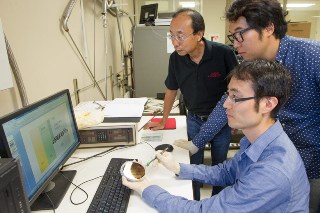Graphene can be used to produce energy-efficient, high-density memory chips. Researchers at Stanford used graphene in three different ways to create data storage technology that has the best features of both volatile and non-volatile silicon chips.
 Professor H.-S. Philip Wong, left, graduate student Joon Sohn and postdoctoral fellow Seunghyun Lee (seated) are developing high-capacity, energy-efficient memory chips that are not based on silicon. (Photo: Norbert von der Groeben)
Professor H.-S. Philip Wong, left, graduate student Joon Sohn and postdoctoral fellow Seunghyun Lee (seated) are developing high-capacity, energy-efficient memory chips that are not based on silicon. (Photo: Norbert von der Groeben)
Phones, laptops and other electronic devices all use memory chips to function. To be desireable they must be fast, have a small profile and consume a small amount of power.
Engineers are presently trying to develop nanomaterial-based memory chips that perform better than their silicon counterparts to be used in low-energy data centers and gadgets with a longer battery life.
Until now, despite its extremely high conductivity, graphene has been used in few practical electronic devices.
Three graphene-centric memory technologies have been described in different articles published in Nature Communications, Applied Physics Letters and Nano Letters journals. These studies were performed by an international group of collaborators led by Professor H.-S. Philip Wong and Pop.
Data storage has become a significant, large-scale consumer of electricity, and new solid-state memory technologies such as these could also transform cloud computing
H.-S Wong - Stanford University
Data is stored by memory chips in the form of ones and zeroes. Silicon-based memory chips are classified as either volatile and non-volatile. Volatile memory can store data only when power is available. Random access memory (RAM) is an example of volatile memory. Non-volatile memory is slow but stable, and it continues to store the data even when power is not available. The flash memory used in cell phones is an example of non-volatile memory.
Engineers led by Stanford have demonstrated a way to create memory that combines the stability of flash memory with the speed of RAM. They used new technologies and materials to create memory that consumed comparatively less energy than silicon.
Graphene is the star of this research. With these new storage technologies, it would be conceivable to design a smartphone that could store 10 times as much data, using less battery power, than the memory we use today.
Prof. Eric Pop - Stanford University
In the RRAM chips metal oxides are changed between conductive and resistive states by the application of a small joly of electricity. in these RRAM chips. A zero is created when the electron flow is resisted by the metal oxides, and a one is created when electrons are conducted by the material.
Like flash memory, RRAM has the ability to store data without power, and it is also fast like volatile silicon memory.
The researchers used graphene to carrying the small jolts of electricity. Graphene is conductive even at very thin dimensions which differentiates it from conventional metals. This enables fabrication of smaller RRAM cells that have the capacity to store more data than conventional metal-based conductors.
The other two study papers were published in Nano Letters and Applied Physics Letters. In these studies, the teams led by Pop and Wong used graphene to advance the phase-change memory concept.
Phase-change memory involves an alloy of germanium, antimony and tellurium. Applying a small jolt of electricity to the alloy results in a change in its structure. The first jolt induces the atoms to form a normal, crystalline structure that facilitates a flow of electrons. This is considered as equivalent to a digital one. The second jolt induces the structure to become amorphous with an irregular structure. This is equivalent to a zero.
The phase-change material toggles from one to zero with each jolt. This material has the ability to store data even when power is not available.
Pop and Wong state that graphene’s unique, thermal, electrical and atomically thin properties could help create data storage with better energy efficiency, and transform the manner in which digital data is stored and accessed in the future.